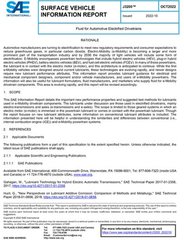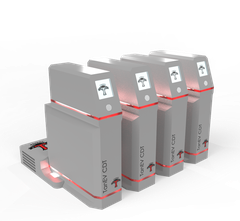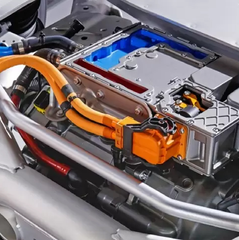Drivers of Custom Testing for Electric Vehicle Drivetrain Fluids
 A glance at the SAE
J3200 document or a review of some recent STLE publications on electric vehicle
(EV) fluid testing shows that custom tests are common for electric vehicle
drivetrain fluids (EDFs) [1,2,3]. In
many cases, the industry has not yet had time to develop tests that address the specific needs of electric vehicles. In
other cases, tests have been developed and are in the process of becoming
standardized tests. In a few cases,
existing test standards are expected to work well for EDFs, and development
will proceed only if new needs are recognized.
However, the most significant barrier to a single set of standardized
tests for all EDFs is the variation in EV drivetrain designs. Different styles
of motor windings require different cooling techniques. Some systems lubricate and cool most of the
drivetrain as well as batteries with one fluid while other systems partition
areas with seals and use different lubricants in each area. There are differences in the number and
placements of motors and the speeds at which the motors, reduction gears, and
bearings operate. With so many hardware variations available, custom tests are
frequently the best way to assess the suitability of a lubricant for a specific
EV application. The SAE J3200 Report is available on the SAE website.
A glance at the SAE
J3200 document or a review of some recent STLE publications on electric vehicle
(EV) fluid testing shows that custom tests are common for electric vehicle
drivetrain fluids (EDFs) [1,2,3]. In
many cases, the industry has not yet had time to develop tests that address the specific needs of electric vehicles. In
other cases, tests have been developed and are in the process of becoming
standardized tests. In a few cases,
existing test standards are expected to work well for EDFs, and development
will proceed only if new needs are recognized.
However, the most significant barrier to a single set of standardized
tests for all EDFs is the variation in EV drivetrain designs. Different styles
of motor windings require different cooling techniques. Some systems lubricate and cool most of the
drivetrain as well as batteries with one fluid while other systems partition
areas with seals and use different lubricants in each area. There are differences in the number and
placements of motors and the speeds at which the motors, reduction gears, and
bearings operate. With so many hardware variations available, custom tests are
frequently the best way to assess the suitability of a lubricant for a specific
EV application. The SAE J3200 Report is available on the SAE website.

Electrifying a Test Method
The most common test modification is to add electrification. This meets the need to understand how the fluid responds when it experiences typical lubricant stresses while in an elevated electric field. Researchers have modified tests to apply voltages across several types of tribometers, gear- or bearing-testing rigs, and directly to test materials like copper wire, insulation materials, or the fluid sample [2,3]. Savant Labs participated in the development of the Conductive Deposit Test, in which a voltage is applied across two disconnected circuits on a test board to see how the voltage impacts the formation of deposits that can create shorts between the circuits.
Testing at Different Temperatures
Another common modification is to complete common tests at multiple temperatures or at different temperatures than those in the specifications. The fluid in an EV is likely to experience many different temperatures depending on where it is at any time. Furthermore, the range of temperatures is likely to be quite different from those in a vehicle with an internal combustion engine. It is most common to adjust the temperature in corrosion and oxidation tests because these properties can be dramatically affected by temperature [2]. For instance, Savant Labs has been offering the Wire Corrosion Test and the instrument is capable of a wide temperature range (depending on the safety of the sample) from room temperature to 160°C.
Testing with Novel Materials
 Because the materials in EV drivetrains include materials not
commonly seen in internal combustion engine drivetrains, many researchers also
adapt common compatibility tests by using different test materials. For instance, Savant Labs can run the wire
corrosion test with wires made from materials other than copper to test the
corrosiveness of these other metals under electrified conditions. The techniques Savant Labs uses for exposing
elastomers to fluids and measuring changes in volume and tensile strength can
also be adapted to novel materials [3].
Because the materials in EV drivetrains include materials not
commonly seen in internal combustion engine drivetrains, many researchers also
adapt common compatibility tests by using different test materials. For instance, Savant Labs can run the wire
corrosion test with wires made from materials other than copper to test the
corrosiveness of these other metals under electrified conditions. The techniques Savant Labs uses for exposing
elastomers to fluids and measuring changes in volume and tensile strength can
also be adapted to novel materials [3].
Testing at Different Loads and Speeds
Finally, the load and speed are frequently adapted from standard test methods to create EDF-specific tests. EV components often operate with faster rotational speeds than those in standardized tests. Furthermore, electric vehicles function with the highest loads at low speeds, while ICE vehicles typically experience high load and speed together [4], so the load-speed combinations called out in many standardized test methods may not be appropriate for a particular electric vehicle lubrication application. For instance, one researcher modified the traditional FZG test by increasing the load at different stages [2]. Savant Labs can modify loads and operating speeds on tribological equipment for the FZG test, the 4-Ball test, and the SRV.
Savant Labs Can Develop a Custom Test for Your Needs
The scientists and technicians at Savant Labs have extensive experience with custom testing. They have developed new tests that have been incorporated as standard test methods and have modified standard test methods to meet a customer’s particular need. The process starts when a client contacts the lab with their need. Technical experts consult with the client to fully understand the need and respond with a test proposal. Savant’s team carefully reviews results for quality and provides interpretive guidance. If you have a testing need that is not met by an existing standardized test, contact Savant Labs today to begin the development of a test to match your application.
[1] SAE J3200_202210 “Fluid for Automotive Electrified Drivetrains” Information Report. October 10, 2022.
[2] Canter, Neil. “Tribology and Lubrication for E-Mobility: Findings from the 2nd STLE Conference on Electric Vehicles.” STLE, Oct. 2023.
[3] McGuire, Nancy. “Test methods for evaluation of electric vehicle drivetrain fluids.” STLE. TLT Webinar October 2023. https://www.stle.org/files/TLTArchives/2023/10_October/Webinar.aspx, accessed Oct. 30, 2023.
[4] Van Rensselar, Jeanna. “The Tribology of Electric Vehicles” Bearing News. June 7, 2019. https://www.bearing-news.com/the-tribology-of-electric-vehicles-2/, accessed Nov. 3, 2023.
